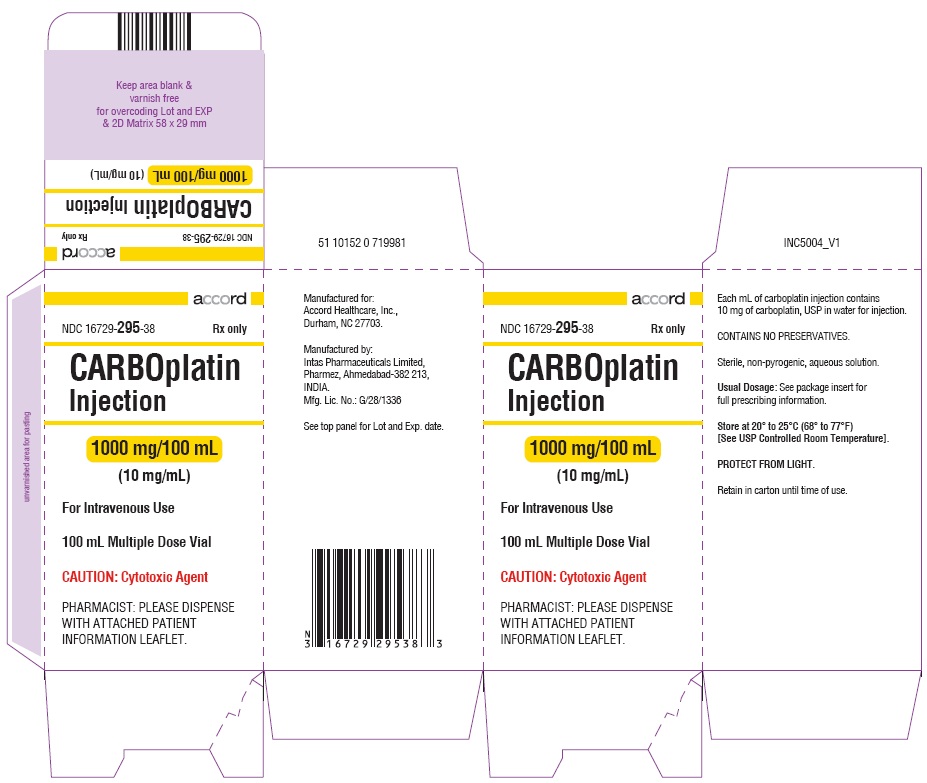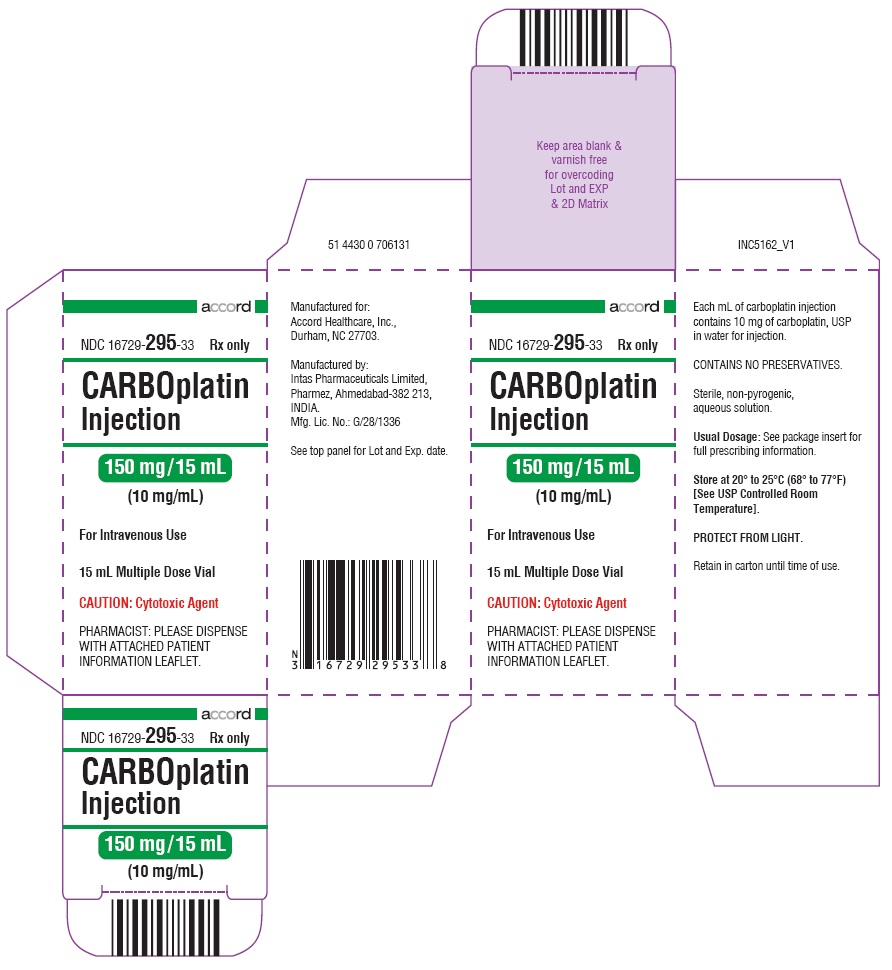Drug Catalog - Product Detail
CARBOPLATIN INJ 600MG/60ML 1X60ML
| NDC | Mfr | Size | Str | Form |
|---|---|---|---|---|
| 16729-0295-12 | ACCORD HEALTHCARE | 60 | 600MG/60ML | SOLUTION |
PACKAGE FILES











Generic Name
CARBOPLATIN
Substance Name
CARBOPLATIN
Product Type
HUMAN PRESCRIPTION DRUG
Route
INTRAVENOUS
Application Number
ANDA206775
Description
DESCRIPTION Carboplatin injection, USP is supplied as a sterile, pyrogen-free, 10 mg/mL aqueous solution of carboplatin, USP. Carboplatin, USP is a platinum coordination compound. The chemical name for carboplatin, USP is platinum, diammine [1,1-cyclobutanedicarboxylato(2-)-0,0']-,(SP-4-2), and carboplatin, USP has the following structural formula: C 6 H 12 N 2 O 4 Pt M.W. 371.25 Carboplatin, USP is a crystalline powder. It is soluble in water at a rate of approximately 14 mg/mL, and the pH of a 1% solution is 5 to 7. It is virtually insoluble in ethanol, acetone, and dimethylacetamide. Structural Formula
How Supplied
HOW SUPPLIED Each mL of carboplatin injection, USP contains 10 mg of carboplatin, USP in water for injection and is available in individual cartons as follows: NDC Number Contents Size 16729-295-31 50 mg 5 mL Multidose Vial 16729-295-33 150 mg 15 mL Multidose Vial 16729-295-34 450 mg 45 mL Multidose Vial 16729-295-12 600 mg 60 mL Multidose Vial 16729-295-38 1000 mg 100 mL Multidose Vial STORAGE Unopened vials of carboplatin injection are stable to the date indicated on the package when stored at 20° to 25°C (68° to 77°F) [See USP Controlled Room Temperature]. PROTECT FROM LIGHT. Carboplatin injection, USP multidose vials maintain microbial, chemical, and physical stability for up to 14 days at 25°C following multiple needle entries. Parenteral drug products should be inspected visually for particulate matter and discoloration prior to administration. Solutions for infusion should be discarded 8 hours after preparation. HANDLING AND DISPOSAL Caution should be exercised in handling and preparing carboplatin injection. Several guidelines on this subject have been published. 1-4 To minimize the risk of dermal exposure, always wear impervious gloves when handling vials containing carboplatin injection. If carboplatin injection contacts the skin, immediately wash the skin thoroughly with soap and water. If carboplatin injection contacts mucous membranes, the membranes should be flushed immediately and thoroughly with water. More information is available in the references listed below.
Indications & Usage
INDICATIONS Initial Treatment of Advanced Ovarian Carcinoma Carboplatin injection is indicated for the initial treatment of advanced ovarian carcinoma in established combination with other approved chemotherapeutic agents. One established combination regimen consists of carboplatin and cyclophosphamide. Two randomized controlled studies conducted by the NCIC and SWOG with carboplatin versus cisplatin, both in combination with cyclophosphamide, have demonstrated equivalent overall survival between the two groups (see CLINICAL STUDIES ). There is limited statistical power to demonstrate equivalence in overall pathologic complete response rates and long-term survival (≥ 3 years) because of the small number of patients with these outcomes: the small number of patients with residual tumor < 2 cm after initial surgery also limits the statistical power to demonstrate equivalence in this subgroup. Secondary Treatment of Advanced Ovarian Carcinoma Carboplatin injection is indicated for the palliative treatment of patients with ovarian carcinoma recurrent after prior chemotherapy, including patients who have been previously treated with cisplatin. Within the group of patients previously treated with cisplatin, those who have developed progressive disease while receiving cisplatin therapy may have a decreased response rate.
Dosage and Administration
DOSAGE AND ADMINISTRATION NOTE: Aluminum reacts with carboplatin causing precipitate formation and loss of potency, therefore, needles or intravenous sets containing aluminum parts that may come in contact with the drug must not be used for the preparation or administration of carboplatin injection. Single Agent Therapy Carboplatin injection, as a single agent, has been shown to be effective in patients with recurrent ovarian carcinoma at a dosage of 360 mg/m 2 intravenously on day 1 every 4 weeks (alternatively see Formula Dosing ). In general, however, single intermittent courses of carboplatin should not be repeated until the neutrophil count is at least 2,000 and the platelet count is at least 100,000. Combination Therapy with Cyclophosphamide In the chemotherapy of advanced ovarian cancer, an effective combination for previously untreated patients consists of: Carboplatin - 300 mg/m 2 intravenously on day 1 every 4 weeks for 6 cycles (alternatively see Formula Dosing ). Cyclophosphamide - 600 mg/m 2 intravenously on day 1 every 4 weeks for 6 cycles. For directions regarding the use and administration of cyclophosphamide please refer to its package insert (see CLINICAL STUDIES ). Intermittent courses of carboplatin in combination with cyclophosphamide should not be repeated until the neutrophil count is at least 2,000 and the platelet count is at least 100,000. Dose Adjustment Recommendations Pretreatment platelet count and performance status are important prognostic factors for severity of myelosuppression in previously treated patients. The suggested dose adjustments for single agent or combination therapy shown in the table below are modified from controlled trials in previously treated and untreated patients with ovarian carcinoma. Blood counts were done weekly, and the recommendations are based on the lowest post-treatment platelet or neutrophil value. Platelets Neutrophils Adjusted Dose Percentages apply to carboplatin injection as a single agent or to both carboplatin and cyclophosphamide in combination. In the controlled studies, dosages were also adjusted at a lower level (50% to 60%) for severe myelosuppression. Escalations above 125% were not recommended for these studies. (From Prior Course) > 100,000 > 2,000 125% 50 to 100,000 500 to 2,000 No Adjustment < 50,000 < 500 75% Carboplatin injection is usually administered by an infusion lasting 15 minutes or longer. No pre- or post-treatment hydration or forced diuresis is required. Patients with Impaired Kidney Function Patients with creatinine clearance values below 60 mL/min are at increased risk of severe bone marrow suppression. In renally-impaired patients who received single agent carboplatin therapy, the incidence of severe leukopenia, neutropenia, or thrombocytopenia has been about 25% when the dosage modifications in the table below have been used. Baseline Creatinine Clearance Recommended Dose on Day 1 41 to 59 mL/min 250 mg/m 2 16 to 40 mL/min 200 mg/m 2 The data available for patients with severely impaired kidney function (creatinine clearance below 15 mL/min) are too limited to permit a recommendation for treatment. These dosing recommendations apply to the initial course of treatment. Subsequent dosages should be adjusted according to the patient's tolerance based on the degree of bone marrow suppression. Formula Dosing Another approach for determining the initial dose of carboplatin injection is the use of mathematical formulae, which are based on a patient's pre-existing renal function or renal function and desired platelet nadir. Renal excretion is the major route of elimination for carboplatin (see CLINICAL PHARMACOLOGY ). The use of dosing formulae, as compared to empirical dose calculation based on body surface area, allows compensation for patient variations in pretreatment renal function that might otherwise result in either underdosing (in patients with above average renal function) or overdosing (in patients with impaired renal function). A simple formula for calculating dosage, based upon a patient's glomerular filtration rate (GFR in mL/min) and carboplatin injection target area under the concentration versus time curve (AUC in mg/mL•min), has been proposed by Calvert. In these studies, GFR was measured by 51 Cr-EDTA clearance. CALVERT FORMULA FOR CARBOPLATIN DOSING Total Dose (mg) = (target AUC) × (GFR + 25) Note: With the Calvert formula, the total dose of carboplatin is calculated in mg, not mg/m 2 . The target AUC of 4 mg/mL•min to 6 mg/mL•min using single agent carboplatin appears to provide the most appropriate dose range in previously treated patients. This study also showed a trend between the AUC of single agent carboplatin administered to previously treated patients and the likelihood of developing toxicity. % Actual Toxicity in Previously Treated Patients AUC (mg/mL∙min) Gr 3 or Gr 4 Thrombocytopenia Gr 3 or Gr 4 Leukopenia 4 to 5 16% 13% 6 to 7 33% 34% Geriatric Dosing Because renal function is often decreased in elderly patients, formula dosing of carboplatin injection based on estimates of GFR should be used in elderly patients to provide predictable plasma carboplatin injection AUCs and thereby minimize the risk of toxicity. PREPARATION OF INTRAVENOUS SOLUTIONS Carboplatin injection is a premixed aqueous solution of 10 mg/mL carboplatin. Carboplatin aqueous solution can be further diluted to concentrations as low as 0.5 mg/mL with 5% Dextrose in Water (D 5 W) or 0.9% Sodium Chloride Injection, USP. When prepared as directed, carboplatin aqueous solutions are stable for 8 hours at room temperature (25°C). Since no antibacterial preservative is contained in the formulation, it is recommended that carboplatin aqueous solutions be discarded 8 hours after dilution.
